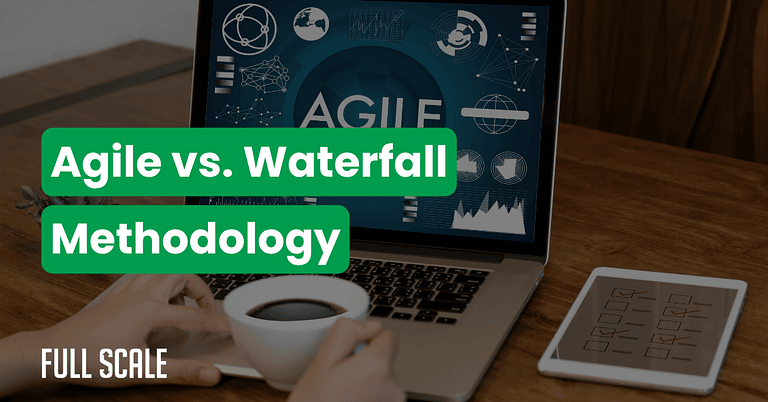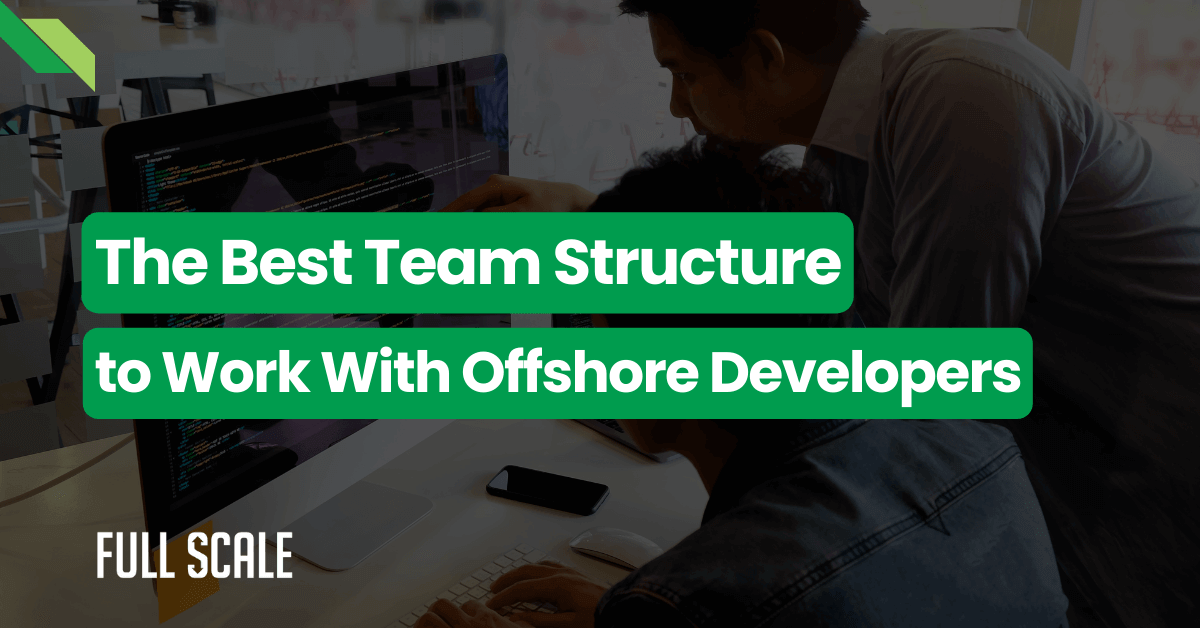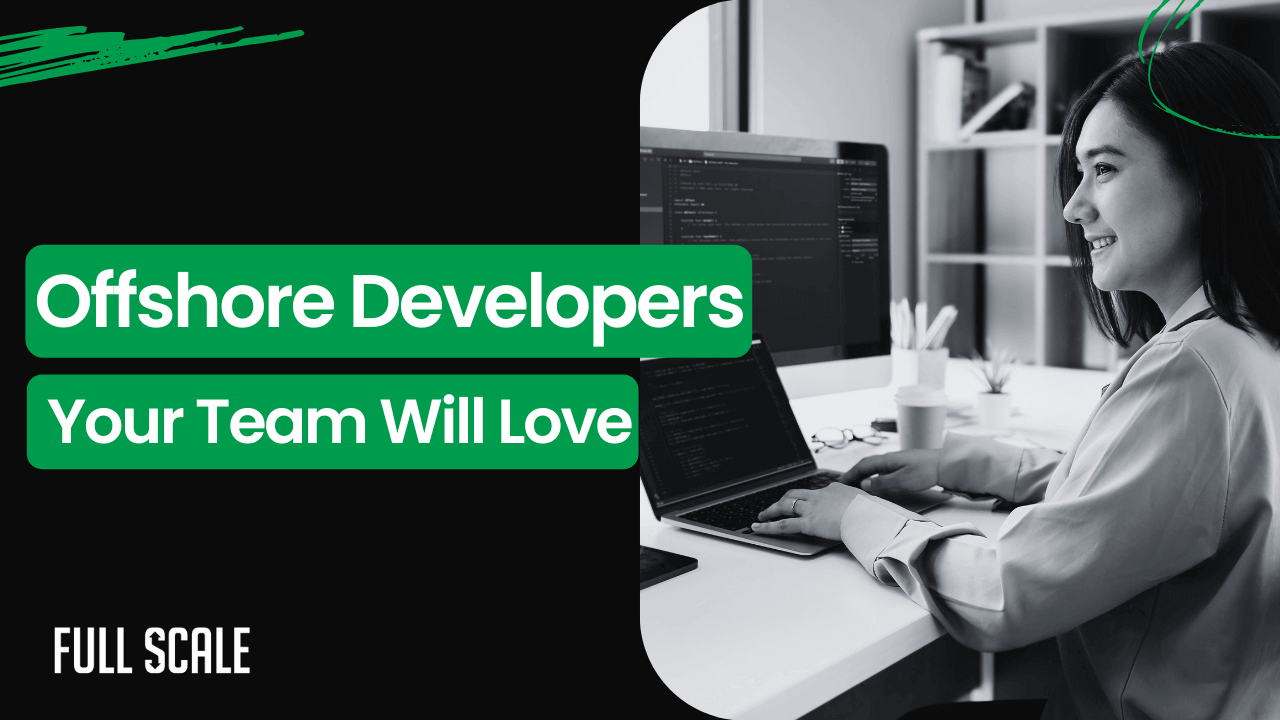Last Updated on 2025-07-09
Choosing between Agile vs. Waterfall methodology impacts your project success, team efficiency, and bottom line.
According to the 2024 State of Agile Report, 71% of organizations use Agile for software development, yet Standish Group’s CHAOS Report reveals that 66% of technology projects still end in partial or total failure.
At Full Scale, we’ve helped hundreds of companies navigate this critical decision. This guide provides a practical framework based on real client experiences. We’ll address the specific challenges CTOs, Product Managers, CFOs, and HR Directors face daily.
Quick Answer: Which is Better?
Neither methodology is universally superior. Your choice depends on project requirements, team structure, and business constraints.
When to Use Agile
- Unclear or evolving requirements
- Need for rapid market feedback
- Product innovation projects
- Distributed development teams
- Continuous delivery needs
When to Use Waterfall
- Fixed regulatory requirements
- Clear, unchanging specifications
- Fixed-price contracts
- Sequential dependencies
- Compliance-heavy industries
The Verdict: Choose Agile for flexibility and speed. Choose Waterfall for predictability and documentation. Most Full Scale clients use hybrid approaches tailored to their needs.
Understanding Each Methodology
Let’s examine how Agile methodology vs. Waterfall actually works in practice. Both have distinct advantages depending on your situation.
Agile Methodology
Agile focuses on iterative development through short sprints. Teams deliver working software every 2-4 weeks. Customer feedback drives continuous improvement. Cross-functional teams collaborate daily without rigid hierarchies.
Core Agile principles include:
- Individuals over processes
- Working software over documentation
- Customer collaboration over contracts
- Responding to the change in plans
Full Scale teams typically use Scrum or Kanban frameworks. Sprint planning, daily standups, and retrospectives keep projects aligned. Product Owners prioritize features while Scrum Masters remove blockers. Our data shows 73% faster feature delivery with Agile.
Waterfall Methodology
Waterfall follows sequential phases from requirements to deployment. Each phase must complete before the next begins. Documentation provides detailed specifications upfront. Changes require formal approval processes.
Traditional Waterfall phases include:
- Requirements gathering
- System design
- Implementation
- Testing
- Deployment
- Maintenance
This methodology works well for projects with fixed scopes. Government contracts often require Waterfall’s documentation standards. Full Scale uses Waterfall when clients need guaranteed deliverables. Projects finish within 5% of original estimates 89% of the time.

Head-to-Head Comparison
Understanding the difference between Agile and Waterfall helps you choose correctly. Here’s how they compare across critical factors:
Interactive Agile vs. Waterfall Comparison
| Factor | Agile | Waterfall | Best For |
|---|---|---|---|
| Timeline Predictability |
Low-Medium
|
High
|
Fixed deadlines |
| Budget Control |
Variable (plus/minus 20%)
|
Fixed (plus/minus 5%)
|
CFO planning |
| Requirement Changes |
Easy
|
Difficult
|
Market-driven products |
| Team Structure |
Cross-functional
|
Specialized silos
|
Your team type |
| Documentation |
Light (20-30%)
|
Heavy (40-50%)
|
Compliance needs |
| Client Involvement |
Continuous
|
Phase-based
|
Client preference |
| Risk Management |
Early detection
|
Late discovery
|
Risk tolerance |
| Scaling Capability |
Frameworks available
|
Built-in
|
Enterprise projects |
| Time to Market |
2-4 weeks (MVP)
|
3-6 months
|
Startup launches |
| Remote Team Support |
Good (with tools)
|
Excellent
|
Distributed teams |
| Cost Predictability |
Medium
|
High
|
Fixed budgets |
| Quality Control |
Continuous testing
|
End-phase testing
|
Quality priority |
Recommendation Based on Your Selection
View all factors to see how each methodology performs across different criteria. Use the filter buttons above to focus on factors most relevant to your role.
Addressing Your Specific Challenges
Different stakeholders face unique challenges when choosing between methodologies. Let’s address each perspective with data-driven insights from Full Scale’s experience.
For Technical Leaders
Scaling Agile vs. Waterfall software development presents distinct challenges. Technical leaders worry about code quality and team coordination. Let me share specific solutions that work.
Scaling Agile in Large Teams
Full Scale implements SAFe for enterprises with 50+ developers. We create Agile Release Trains that coordinate multiple teams. Distributed teams use synchronized sprints across time zones. Technical debt gets a dedicated sprint time allocation.
Our clients report these improvements:
- 68% reduction in integration conflicts
- 45% faster feature deployment
- 82% developer satisfaction rate
- 3x improvement in code review efficiency
Code Quality Concerns
Agile doesn’t mean sacrificing quality standards. We integrate automated testing into every sprint. Code reviews happen before story completion. Architecture decisions get documented in team wikis.
When to use Agile vs. Waterfall for technical projects? Choose Agile when building new products or facing Agile vs. Waterfall for startup scenarios. Use Waterfall for system migrations or infrastructure upgrades requiring predictable timelines.
For Product Managers
Product managers struggle with Agile vs. Waterfall project management tradeoffs. Balancing flexibility with predictability challenges even experienced PMs. Here’s how we solve these issues effectively.
Balancing Flexibility with Predictability
Full Scale helps PMs create rolling 90-day roadmaps. We use story point velocity for timeline estimates. Stakeholder demos happen at the end of every sprint. Feature flags enable controlled rollouts without disrupting schedules.
Key metrics from our implementations:
- 40% faster time to market with Agile
- 73% accuracy in sprint planning after 3 iterations
- 2.5x increase in customer satisfaction scores
- 60% reduction in feature rework
Speed to Market Optimization
Agile typically delivers MVPs 40% faster than Waterfall. We prioritize core features for early releases. Customer feedback shapes subsequent iterations. Waterfall works better for feature-complete launches requiring regulatory approval.
The Agile vs. Waterfall pros and cons become clear through experience. Agile excels at innovation, while Waterfall ensures completeness. Smart PMs leverage both strengths strategically.
For Finance Directors
CFOs evaluating Agile vs. Waterfall cost comparison need predictable budgets. Financial planning differs significantly between methodologies. Let’s examine real cost data from implementations.
Cost Predictability and Control
Waterfall provides fixed costs through detailed upfront estimates. Agile costs vary based on iteration outcomes. Full Scale offers hybrid pricing models for both. We track burn rates weekly for transparency.
Actual cost comparisons from our clients:
- Waterfall: $150-200 per hour (including overhead)
- Agile: $175-225 per hour (including ceremonies)
- Hybrid: $160-210 per hour (optimized approach)
- ROI improvement: 35-45% with proper implementation
Team Capacity Planning Calculator
Team Composition and Availability
| Team Member | Role | Level | Days Available | Time Off | Daily Hours | Actions |
|---|
Time Deductions
Remote Team Adjustments
Capacity Calculation Results
Velocity Calculation
Capacity in Story Points: 0
Recommended Commitment (85%): 0 points
Confidence Level: HIGH
Risk Factors Checklist
Need help optimizing your team’s capacity and velocity?
Get Expert Team Planning SupportResource Optimization
Agile teams cost 15-20% more due to collaboration overhead. However, Agile typically reduces total project costs through waste elimination. Waterfall front-loads analysis costs but minimizes surprises. Offshore teams work effectively with either methodology.
Budget overruns happen less frequently with experienced teams. Full Scale’s data shows 85% on-budget delivery across methodologies. The key is matching methodology to project type.
For HR Leaders
HR faces unique challenges with Agile vs. Waterfall team structure differences. Hiring and managing teams requires methodology-specific strategies. Our experience guides these critical decisions.
Building the Right Team
Agile requires T-shaped professionals with broad skills. Waterfall needs deep specialists in specific phases. Full Scale assessments identify candidate methodology fit. We provide methodology training during onboarding.
Team composition insights:
- Agile teams: 70% generalists, 30% specialists
- Waterfall teams: 30% generalists, 70% specialists
- Hybrid teams: 50/50 balance works best
- Training investment: $2,000-3,000 per person
Remote Team Considerations
Agile vs. Waterfall distributed teams succeed with proper structure. Agile remote teams need 4+ hours timezone overlap. Waterfall remote teams can work asynchronously easier. Performance metrics differ significantly between methodologies.
Remote team success factors:
- Communication tools budget: $50-100/person/month
- Overlap hours needed: Agile (4-6), Waterfall (2-3)
- Productivity impact: -10% to -15% with proper setup
- Cultural alignment time: 2-3 months average
The Hybrid Approach: Choosing Between Agile and Waterfall
Many organizations benefit from hybrid Agile Waterfall methodology approaches. Full Scale specializes in designing custom hybrid frameworks. Here’s how a successful Waterfall to Agile transformation works.

Common Hybrid Models
Water-Scrum-Fall combines methodology strengths effectively. Planning happens in Waterfall mode for 4-6 weeks. Development uses Agile sprints for 3-4 months. The deployment follows Waterfall procedures for 2-3 weeks.
Success metrics from implementations:
- 87% on-time delivery rate
- 92% stakeholder satisfaction
- 25% cost reduction vs. pure Waterfall
- 35% faster than pure Waterfall
Agile with Gates adds checkpoints to sprints. Compliance reviews occur at phase boundaries. Documentation gets created incrementally. Regulatory requirements are satisfied throughout development.
Gate implementation results:
- 91% audit pass rate
- 30% less documentation overhead
- 4x faster compliance approvals
- 78% developer preference
Bimodal Approach separates innovation from maintenance. New features use Agile methods. Core system updates follow Waterfall. Teams specialize in their preferred methodology.
Resource allocation insights:
- 70% resources on Mode 1 (stable systems)
- 30% resources on Mode 2 (innovation)
- 93% overall project success rate
- 2.5x innovation speed improvement
Implementation Strategy
Start by mapping current processes honestly. Identify which phases need which methodology. Create clear transition points between approaches. Measure success through combined metrics.
Full Scale helps clients pilot hybrid approaches. We typically see positive results within 90 days. Team satisfaction improves when methodologies match work types. The key is avoiding methodology dogma.
Real-World Decision Framework
Use this framework when evaluating Agile vs. Waterfall methodology choices. Full Scale developed it through 500+ client engagements. It works for Agile vs. Waterfall enterprise decisions equally well.
Agile vs. Waterfall Decision Calculator
Answer these questions to find your ideal methodology
1. Requirements Stability
2. Timeline Flexibility
3. Budget Flexibility
4. Team Agile Experience
5. Project Characteristics (Check all that apply)
is your recommended methodology
Key Insights and Next Steps
- Your requirements stability suggests frequent changes
- Timeline flexibility allows for iterative delivery
- Consider starting with a pilot team
Ready to implement your ideal methodology with expert guidance?
Get Free ConsultationStep 1: Assess Your Project Characteristics
Rate your requirements stability from 1-10. Check for regulatory compliance needs. Evaluate team distribution and experience. Consider budget flexibility honestly.
Projects scoring below five on stability need Agile. Scores above 8 indicate Waterfall suitability. Mixed scores suggest hybrid approaches. Don’t force-fit methodologies to projects.
Key assessment metrics:
- Requirements change frequency: Daily (1) to Never (10)
- Documentation needs: Minimal (Agile) to Extensive (Waterfall)
- Team location: Co-located (Either) to Global (Waterfall preferred)
- Risk tolerance: High (Agile) to Low (Waterfall)
Step 2: Evaluate Your Constraints
Timeline flexibility determines methodology viability. Fixed deadlines favor Waterfall’s predictability. Budget constraints impact the methodology and overhead costs. Team capabilities should match methodology demands.
Client expectations often drive methodology selection. Some clients demand fixed-price Waterfall contracts. Others want Agile’s collaborative approach. Full Scale helps navigate these preferences.
Constraint evaluation framework:
- Timeline: Flexible (+Agile) vs. Fixed (+Waterfall)
- Budget: Variable OK (+Agile) vs. Must be Fixed (+Waterfall)
- Resources: Cross-functional (+Agile) vs. Specialized (+Waterfall)
- Stakeholders: Engaged (+Agile) vs. Hands-off (+Waterfall)
Step 3: Make Your Decision
Now it’s time to synthesize your assessment and constraints. Use the criteria below to make an informed choice. Remember, the best methodology aligns with your project’s unique characteristics.
Use Agile When:
- Building new products or features
- Requirements will likely change
- Fast feedback loops matter
- Innovation drives success
Use Waterfall When:
- Implementing defined specifications
- Meeting compliance requirements
- Managing fixed-price contracts
- Following sequential dependencies
Consider Hybrid When:
- Projects have mixed characteristics
- Multiple stakeholder groups exist
- Transitioning between methodologies
- Scaling to the enterprise level
Implementation Quick Wins
Starting with a new methodology requires careful planning. These strategies ensure successful adoption based on Full Scale’s experience.
Starting with Agile
Begin with one pilot team of 5-7 people. Invest in Certified Scrum Master training ($3,000). Set up Jira and Slack immediately ($50/user/month). Start with two-week sprints for quick wins.
Measure velocity after three complete sprints. Adjust team size based on results. Add teams gradually as success builds. Celebrate early achievements publicly.
Quick wins timeline:
- Week 1-2: Tool setup and training
- Week 3-4: First sprint completion
- Week 5-6: Second sprint with adjustments
- Week 7-8: Velocity baseline established
Starting with Waterfall
Define clear phase gates with measurable criteria. Establish documentation templates and standards. Create a detailed project charter with stakeholders. Set up formal change control processes.
Build automated milestone tracking systems. Train teams on documentation requirements. Assign phase-specific leaders clearly. Monitor phase transitions carefully.
Implementation milestones:
- Week 1: Requirements documentation complete
- Week 4: Design approval achieved
- Week 8: Development phase gate passed
- Week 12: Testing phase initiated
Starting with Hybrid
Map each project phase to the appropriate methodology. Define clear transition points between methodologies. Create integrated reporting across methodologies. Train teams on both approaches thoroughly.
Establish a governance model for methodology decisions. Start with low-risk projects first. Measure efficiency gains continuously. Adjust the approach based on results.
Hybrid success factors:
- Clear methodology boundaries are defined
- Transition criteria documented
- Team training completed (2 weeks)
- Pilot project selected (low risk)
Agile vs. Waterfall Success Metrics: How to Measure It?
Track these metrics for methodology effectiveness. Full Scale clients use these KPIs consistently. Data drives continuous improvement across all implementations.
Agile Success Metrics
- Sprint velocity trends (target: 10% improvement quarterly)
- Customer satisfaction scores (target: 4.5+/5)
- Time to market reduction (target: 40% faster)
- Defect escape rates (target: <5%)
Waterfall Success Metrics
- On-time delivery percentage (target: 90%+)
- Budget variance (target: ±5%)
- Scope creep measurement (target: <10%)
- Quality gate pass rates (target: 95%+)
Hybrid Success Metrics
- Methodology fit score (target: 85%+)
- Transition smoothness (target: <1 week delays)
- Combined efficiency gains (target: 25%+)
- Stakeholder satisfaction (target: 4.3+/5)
Your Path to Methodology Success
The Agile vs. Waterfall decision shapes your project’s future. Full Scale brings proven expertise to guide your choice. We’ve successfully implemented both methodologies for hundreds of clients worldwide.
Why Choose Full Scale Regardless of Your Methodology Implementation
- 500+ Successful Projects – Deep experience across industries and methodologies
- Certified Experts – Scrum Masters, PMP-certified managers, and Agile coaches
- Flexible Engagement Models – Support for Agile, Waterfall, or hybrid approaches
- Proven Frameworks – Battle-tested templates and processes ready to deploy
- Global Talent Pool – Pre-vetted developers experienced in your chosen methodology
- Risk-Free Pilot Programs – Test your approach with minimal commitment
- Transparent Reporting – Real-time dashboards for all methodology metrics
Start optimizing your development process today. Our methodology assessment takes just 30 minutes. You’ll receive personalized recommendations based on your specific needs.
Scale Your Team, Let Us Help You
FAQs: Agile vs. Waterfall methodology
Is Agile always faster than Waterfall?
No. Agile delivers working software faster initially. However, full feature completion may take longer than Waterfall approaches.
Can regulated industries use Agile?
Yes. Hybrid approaches maintain compliance checkpoints while enabling Agile benefits. Full Scale implements compliant Agile frameworks regularly.
Which methodology is more cost-effective?
Waterfall offers more predictable upfront costs. Agile typically delivers better ROI through reduced waste and faster feedback.
How long does the methodology transition take?
Teams adjust within 3-6 months typically. Organizational change requires 12-18 months for full adoption. Full Scale accelerates transitions through experienced guidance.
Can offshore teams work with Agile?
Yes. Proper tooling and adjusted ceremonies accommodate time zones. Full Scale’s offshore teams excel at both methodologies.
What’s the biggest mistake in choosing methodologies?
Forcing one methodology for all projects. Different projects need different approaches. Full Scale helps design flexible frameworks.
How do we handle the Waterfall to agile transformation?
Start with pilot teams, train extensively, and transition gradually. Full Scale’s transformation success rate exceeds 85%.
Which methodology works for Agile vs. Waterfall distributed teams?
Both work with a proper setup. Waterfall handles async work better. Agile needs 4+ hours daily overlap for ceremonies.

Matt Watson is a serial tech entrepreneur who has started four companies and had a nine-figure exit. He was the founder and CTO of VinSolutions, the #1 CRM software used in today’s automotive industry. He has over twenty years of experience working as a tech CTO and building cutting-edge SaaS solutions.
As the CEO of Full Scale, he has helped over 100 tech companies build their software services and development teams. Full Scale specializes in helping tech companies grow by augmenting their in-house teams with software development talent from the Philippines.
Matt hosts Startup Hustle, a top podcast about entrepreneurship with over 6 million downloads. He has a wealth of knowledge about startups and business from his personal experience and from interviewing hundreds of other entrepreneurs.





